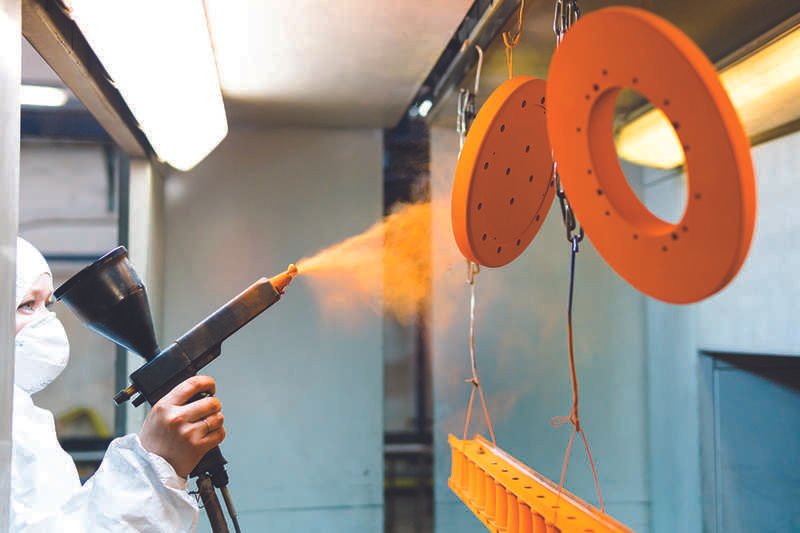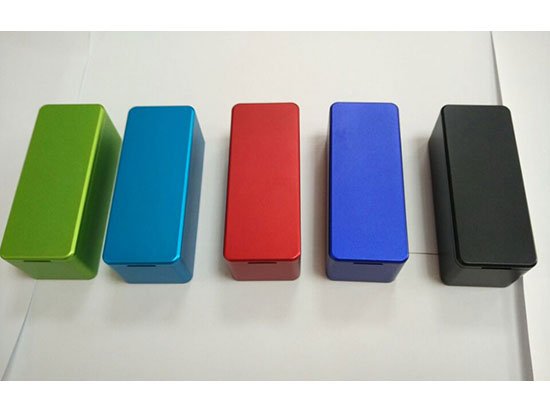When you want the most reliable and durable product finishing process then it must be powder coating. Because it gives a quality appearance, superior color retention, and less wear because of the thermal bonding. Powder coat finish also renders overall ameliorated physical and mechanical properties of the customized parts.
It is extensively used by manufacturers in numerous industries for various applications. In this article, a detailed overview of powder coating will be presented. It covers an explanation regarding the working principle, the material used, and the pros and cons of a powder finish. This piece also provides a few important tips that will help you to optimize the process to get refined outputs.

What is Powder Coating?
Powder coating is a finishing process in which dry, free-flowing, thermoplastic, or thermoset powder material is applied (electrostatically) to a surface and then cured under heat or with ultraviolet light. It helps to achieve great product finishes in respect of functionality and appearance.
Powder coat finish is suitable for various materials, including metals, plastics, glass. UV curable powder coatings enable the finishes of materials like MDF (medium-density fiberboard), carbon fiber, etc. It also induces part beautification by offering a flexible range of colors, finishes, and textures which are not inherited in other traditional coating methods.
Now let’s dive into the working principle of powder coating. It will clear the concepts further.
How Does Powder Coating Work?
Powder coating is a dry finishing process that makes use of powdered coating material to bring a refined end product. Before applying the powder, the CNC parts surface is heated. Then the powder is applied, melted, and then dried and hardened into a fine surface coating.
To carry out the process, a spray gun, spray booth, and curing oven are required. The powder coating process consists of various composite steps. Typically it includes surface preparation, coating application, and curing stage.
Surface Preparation
The effectiveness of the surface preparation stage will determine the quality of the part finish. If not carefully implemented then it will deprive of obtaining the desired results. Before applying any powder coating material, the surface of the machined parts must be cleaned from any contaminations. Any dust, dirt, or other residue contaminate particles will disturb the seamless adhesion of the powder on the part surface.
Some common cleaning processes used during the part preparation stage are cleaning, blasting etching, rinsing, drying, etc. And blast rooms, wash stations, dry-off ovens, etc. are among the most widely used cleaning equipment.
Every cleaning process and equipment is critical in their applications. For example, blast rooms are used to clean those surfaces containing rust and scaling. It uses pressurized fluid (often compressed air) in an enclosure to propel the abrasive material against the part’s surface. Consequently, the abrasive removes the surface dust, dirt, and debris and creates a cleaner and smoother surface which then contributes to the production of a durable and even surface finish.
On the other hand, a wash station is preferred to get rid of contaminated particles like grease and solvent. It sprays the parts with hot water, steam, or detergent to scrub the product exterior. Thus, it assists in chemically preparing or cleaning the surface before applying powder coating. Some part materials need a dry-off oven to evaporate water or solutions from washed or rinsed parts. It also aids to heat parts to an optimum temperature for the powder coating application stage.
Powder Coat Application Stage
There are two primary methods used to apply a powder coat finish i.e. electrostatic deposition (ESD) and fluidized bed powder coating. The manufacturers and finishing service providers determine which methods are to be utilized according to the type of coating material being suitable.
Electrostatic Deposition (ESD)
After completing the CNC machining process, if the custom parts need surface finishes to shine and decorate their exterior then mostly, the coating material is applied via electrostatic spray deposition. ESD method uses a powder feeder, a powder spray booth, and an electrostatic spray gun.
The spray gun transmits an electrical charge onto a fluidized powder material and the gun is fed from the feeder unit. Then it is applied to the substrate. ESD controls the material wastage through a specialized recovery system to collect any overspray material. Which can be reused again for the next coating.
There are three types of ESD guns used oftentimes i.e. Tribo, Corona, and Bell. The main difference between these guns is how powder materials are being charged. In Tribo guns, the powder material is charged when it passes through a dissimilar material, such as the gun barrel.
On the other hand, Corona spray guns charge the powder particles through a charging electrode powered by a power unit. This charging electrode interacts with the powder as it passes through the front of the gun. But Bell guns use both conduction and corona discharge to impart an electrostatic charge to the powder’s particles.
Fluidized Bed Powder Coat
The fluidized bed powder coating process starts by heating the CNC machined parts that require finishing. After that, these heated parts are either dipped directly into a container of fluidized powder or passed through an electrically charged cloud of powder. This product finishing process finds appropriate when coating between 10-15 mils with the final thickness depending on the heating temperature and dipping time in the charged powder.
Coated Part Curing Stage
Once custom-made parts are coated, next comes their curing stage. How a part will be cured depends on which powder coating method was used. For parts coated with ESD, a powder curing oven is used. The specifications, which include temperature and time, are decided as per part’s size, shape, material, etc. Small parts would require less heating for shorter times and large and complex parts would be heated for longer periods. Ideally, a powder curing oven would take 10 to 60 minutes for a temperature ranging from 325- and 450 °F.
But for parts being coated in a fluidized bed, they are already been heated in a powder curing oven. After applying powder coating finish, the assembly, packaging, and shipping of the parts can be dealt with easily after they are cool enough to handle.
Powder Coating Materials Used for CNC Machined Parts
Powder coating material plays a huge role to produce a high-quality part finish. There are mainly three types of powder coat finishing materials. Every type has different material choices to select from. Selecting a perfect material is influenced by its cost and other factors also. But each powder material intends to provide certain finishing attributes. These include
Thermoplastic Powder Coating Materials
Thermoplastics are synthetic materials that possess diverse attributes and applications, especially in customized parts manufacturing. After interacting with critical temperatures, they melt and spread over the part surface. Then cooled to solidify and they reflect enhanced chemical and mechanical strengths to yield quality surface finishes. Thermoplastics append
Polyvinyl Chloride (PVC)
PVC coatings are ideal for durable, smooth, and glossy finishes. These find an immense application on a variety of materials because they possess magnificent properties mostly suitable for a nice and long-lasting coating.
PVC ranks higher for its hardness and durability. It is readily available and cost-effective, it offers superb tensile strength. It shows resistance to several solvents, and spray. PVC also offers good dielectric strength that makes it favorable in electrical applications.
Polyester
Polyesters are the most commonly used coating powder materials. They offer coating-friendly properties such as good mechanical resistance, (considering excellent flexibility and impact resistance), good chemical resistance, and also introduce good overbake resistance against yellowing.
Its demerits include as it offers low cure temperature. Nutshell, if custom parts are to be used outdoor then polyesters should be your highest priority. Because it will provide them with excellent wearability and durability.
Nylon
Nylon is also a very good material to be considered for coating. Its finishes are durable, long-lasting, and render resistance to materials. It also protects solvents and chemicals. Its low friction coefficient makes nylon to be preferable as a coating material on gears and conveyor parts.
Thermoset Powder Coating Materials
Thermosets are a very good option to be applied as powder coating on different customized parts. They are obtained from three common types of resins i.e. epoxy, polyester, and acrylic.
The application process of thermoset powder coating materials is alike to thermoplastic powder coating materials with a minor difference. The thermosets have to undergo chemical cross-linking reactions. Mostly thermosets cure harder than thermoplastic materials.
Cross-linking reactions of the thermosets result in a few changes in their physical properties and these attributes are the demand to get a sustainable finish. For example cross-linking makes these plastics harden.
Epoxy
Materials coated using epoxy finish are hard and electrically insulating. When they come in contact with ultraviolet radiations, they transform into brittle and their quality may disturb. Therefore, parts coated with epoxy are preferred to apply for indoor applications.
Epoxy-Polyester Hybrid
Epoxies and polyesters are combined to get epoxy-polyester hybrids. They are mixed proportionally to get desired properties of either epoxy or polyester. These hybrids when the mixed result in superior weather degradation properties.
Epoxy-Polyester Hybrids adhere to pure epoxies regarding properties. By anyhow, the inclusion of the polyesters increases overbake resistance and creates ultra-smooth, thin films. These are typically used on indoor appliances like pipes, household items like furniture, and domestic appliances like stoves.
Acrylic
Acrylic powder coatings meld with parts exterior that generates a glossy surface. Mostly preferred for coating CNC machined automobile parts such as exposed engine parts needing shiny finishes.
Pros and Cons of Powder Coat Finish
Powder coating finishes have a dry, free-flowing carrier that can generate thicker coatings than conventional liquids. But it has some pros and cons. These include the following
Pros of Powder Coating
It offers a wide range of finishes.
It helps to protect against scratches, corrosion or fading.
It provides a consistent color finish across the metal surface.
It offers economical and durable quality finishes.
It can create thicker coatings than traditional liquid coatings.
Its non-toxic and less flammable properties make it environmentally friendly.
Cons of Powder Coating
Producing thin coatings might be difficult.
It is not recommended to apply for larger surfaces.
It may be hard to coat non-metal surfaces.
Part preparation requires higher temperatures that may distort the integrity of the product.


